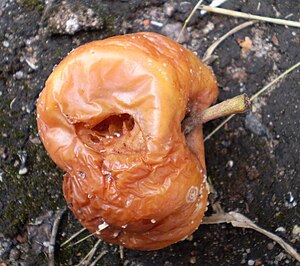Food spoilage

Spoilage is the process in which food deteriorates to the point in which it is not edible to humans or its quality of edibility becomes reduced. Various external forces are responsible for the spoilage of food. Food that is capable of spoiling is referred to as perishable food.
Reasons
Harvested foods decompose from the moment they are harvested due to attacks from enzymes, oxidation and microorganisms. These include bacteria, mold, yeast, moisture, temperature and chemical reaction.
Bacteria
Bacteria can be responsible for the spoilage of food. When bacteria breaks down the food, acids and other waste products are created in the process.[1] While the bacteria itself may or may not be harmful, the waste products may be unpleasant to taste or may even be harmful to one's health.[2]
Useful bacteria
Vinegar Bacteria: Acetobacter sp.
Lactic acid bacteria: Lactobacillus sp.
Yeasts
Yeasts can be responsible for the decomposition of food with a high sugar content. The same effect is useful in the production of various types of food and beverages, such as bread, yogurt, cider, and alcoholic beverages.[3]
Signs
Signs of food spoilage may include an appearance different from the food in its fresh form, such as a change in color, a change in texture, an unpleasant odour, or an undesirable taste. The item may become softer than normal. If mold occurs, it is often visible externally on the item.
Consequences
Spoilage bacteria do not normally cause "food poisoning"; typically, the microorganisms that cause foodborne illnesses are odorless and flavourless, and otherwise undetectable outside the lab.[4][5] Eating deteriorated food could not be considered safe since for example molds produces mycotoxins.
Prevention
A number of methods of prevention can be used that can either totally prevent, delay, or otherwise reduce food spoilage.
Food rotation system uses the first in first out method (FIFO), which ensures that the first item purchased is the first item consumed.
Preservatives can expand the shelf life of food and can lengthen the time long enough for it to be harvested, processed, sold, and kept in the consumer's home for a reasonable length of time.
Refrigeration can increase the shelf life of certain foods and beverages, though with most items, it does not indefinitely expand it. Freezing can preserve food even longer, though even freezing has limitations.
A high-quality vacuum flask (thermos) will keep coffee, soup, and other boiling-hot foods above the danger zone (140F/58C) for over 24 hours.
Canning of food can preserve food for a particularly long period of time, whether canned at home or commercially. Canned food is vacuum packed in order to keep oxygen out of the can that is needed to allow bacteria to break it down. Canning does have limitations, and does not preserve the food indefinitely.[6]
Lactic acid fermentation also preserves food and prevents spoilage.
See also
References
- ^ Tull, Anita (1997), Food and nutrition (3 ed.), Oxford University Press, p. 154, ISBN 978-0-19-832766-0
- ^ Tricket, Jill (2001-07-15). The prevention of food poisoning. p. 8. ISBN 978-0-7487-5893-7.
- ^ Tricket, Jill (2001-07-15). The prevention of food poisoning. p. 9. ISBN 978-0-7487-5893-7.
- ^ Food spoilage and food pathogens, what’s the difference? October 22, 2015, Michelle Jarvie, Michigan State University [1]
- ^ Jeanroy, Amelia; Ward, Karen. Canning & Preserving for Dummies. p. 39.
- ^ Jeanroy, Amelia; Ward, Karen. Canning & Preserving for Dummies. p. 41.
